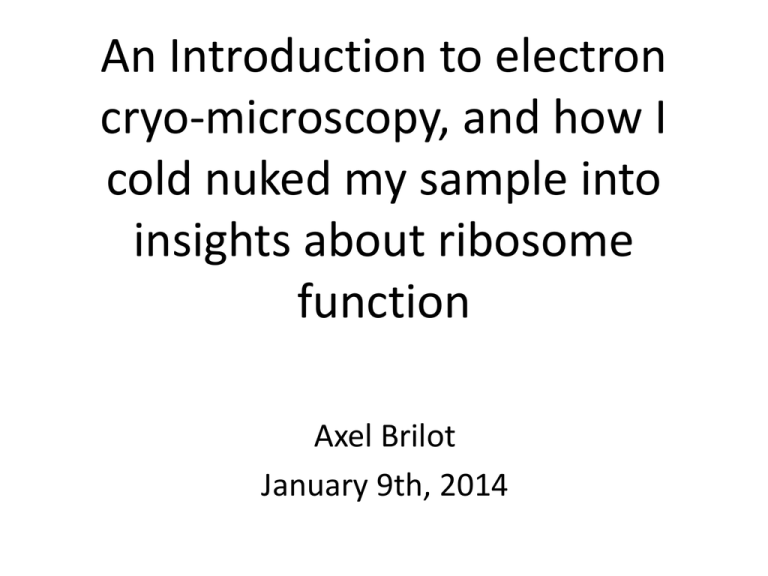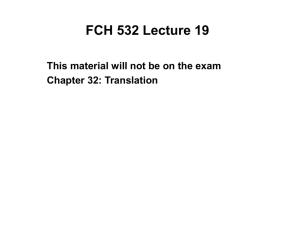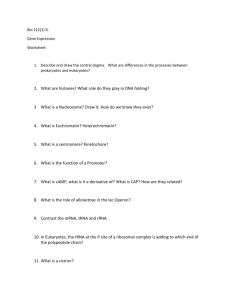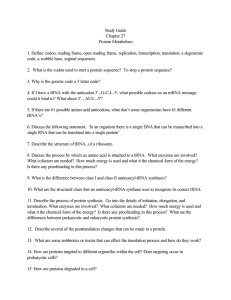An Introduction to electron cryo-microscopy, and how I insights about ribosome
advertisement

An Introduction to electron cryo-microscopy, and how I cold nuked my sample into insights about ribosome function Axel Brilot January 9th, 2014 The Central Dogma The Central Dogma Complex Molecular Machine ~55 polymers > 100’000 atoms per complex Why Structure? The ribosome is a complex molecular machine that adopts various states during its function. Snapshots of these states allow us to gain insights into how it functions, such as how tRNA moves through the ribosome, how chemistry is facilitated, how the ribosome selects the correct tRNA… Some of these states are very hard to visualize, as they are transient. Electron Microscopes Philips CM300 Courtesy of Alexis Rohou FEI F30 Similarities with Light Microscopy Composed of the same basic parts: “Light” Source Condenser lenses Sample holder Objective lens Projector lenses Camera Designed to record an image of a sample Inspired/Stolen from Nikolaus Grigorieff From: Principles and Practice of Electron Microscope Operation. Agar, Alderson & Chescoe Dissimilarities with Light Microscopy Lenses Magnetic lenses vs. glass lenses Different aberrations Magnification/Resolving Power Related to the wavelength of light ~ 100 nm for a light microscope Better than 0.1 nm for a TEM Mechanism of Image formation Phase contrast, amplitude contrast Inspired/Stolen from Nikolaus Grigorieff From: Principles and Practice of Electron Microscope Operation. Agar, Alderson & Chescoe Dissimilarities with light microscopy you might actually care about Vacuum Samples in EM must be “dry” Dry samples are usually dead Radiation Damage Electrons are ionizing radiation Severely limits the dose allowed Inspired/Stolen from Nikolaus Grigorieff From: Principles and Practice of Electron Microscope Operation. Agar, Alderson & Chescoe Dissimilarities with light microscopy you might actually care about InGaAs (a=5.87 Å) [101] 2.94 Å 1.3 Å Grigorieff & Cherns, Phil. Mag. A, 1993. Length scales studied by EM and other imaging methods Stolen from Nikolaus Grigorieff Length scales studied by EM and other imaging methods Single Particle EM Stolen from Nikolaus Grigorieff Sample Preparation: Holey Grids and Plunge Freezing Wang & Sigworth, Physiology, 2009 0 0.5 ms Kasas et al., J. Micros. 211(1):48 (Stolen from Alexis Rohou 1 ms Imaging & Reconstruction Imaging & Reconstruction Imaging & Reconstruction Why Single-Particle EM? Technique Advantage Problem Diffraction (X-ray, electrons) Fast data collection Atomic resolution No weight limit Crystals needed Large amounts of protein needed NMR No crystals needed Fast data collection Atomic resolution Protein dynamics Weight limit ≈ 50 kD Large amounts of protein needed Single particle electron microscopy No crystals needed Can get data from heterogeneous samples No upper weight limit Little protein needed Hard to get atomic resolution Slow data collection Lower weight limit ≈ 200 kD Courtesy of Niko Structure of the ribosome with elongation factor G trapped in a pretranslocation state The 70S Ribosome Tertiary structures of the 30S (A) and 50S (B) subunits, seen from the interface side 30S: 1 RNA, 1522 nt 20 proteins Kaczanowska, M. et al. 2007. Microbiol. Mol. Biol. Rev. 71(3):477-494 50S: 2 RNA, 2893 nt, 120 nt 33 proteins The 70S Ribosome 3 tRNa binding sites at the interface: A( Acceptor), P (Peptidyl), E (Exit) 1 mRNA binding site on the 30S subunit Munro, JB. et al. 2007. TiBS. 71(3):477-494 Translation Stolen brom Biochemistry, Seventh Edition, 2012, Freeman and Company. Translation Pre-translocation Critical step during elongation Move peptidyl tRNA from A to P site Move deacylated tRNA from P to E site Spontaneous function of the ribosome Accelerated 4-5 order of magnitude by EF-G Move 2 tRNA 20-30 Angstroms Maintain the reading frame Allow for in vivo elongation rate of 15-20 a.a./s Stolen brom Biochemistry, Seventh Edition, 2012, Freeman and Company. Post-translocation What is the role of EF-G? Antibiotics in Translocation Munro, JB. et al. 2010. NSMB. 17(12):1470-7 Steric clash of EF-G with A site in Post-translocation state. EF-G Agirrezabala, X. et al. 2009. Q. Rev. Biophys. 42(3):159-200 Antibiotics in Translocation Munro, JB. et al. 2010. NSMB. 17(12):1470-7 The Raw Data 1.35 Million particles, collected on a Titan Krios Microscope at 300 kV. The Expectation-Maximization algorithm The Results I. 3 tRNA (26.7%) II. EF-G, P & E tRNA (13.4%) IV. A/P & P/E tRNA (3.5%) III. EF-G, P site tRNA (6.8%) V. EF-G, A/P & P/E tRNA (2.4%) Conformational Changes of EF-G View of EF-G with pre and posttranslocation 50S subunits aligned shows a rotation around the immobile SRL View of EF-G with domains I-II aligned shows movement of domains III-IV-V relative to domains I-II EF-G binding induces a new tRNA hybrid state EF-G: Pre-translocation A/P*: EF-G Bound, pre-translocation state A/P*: No EF-G bound, pre-translocation state P/P: Classical Post-translocation State Schematic of EF-G catalyzed translocation Schematic of EF-G catalyzed translocation Our Collaborators Andrei Korostelev U. Mass. Med. TSV IRES Dmitri Ermolenko U. Rochester Med. Center EF-G complexes Acknowledgments Brandeis University Grigorieff Group Chen Xu Alexis Rohou Mike Rigney Janelia Farm Zhiheng Yu Jason De La Cruz Funding



